Swami Sharddhananda and Mahatma Gandhi
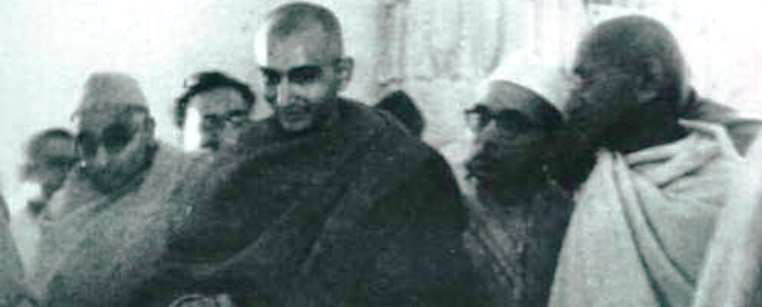
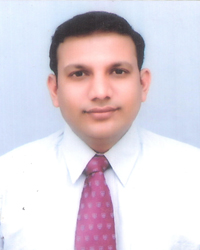
Author
Dr. Vivek AryaDate
23-Dec-2014Category
ArticleLanguage
EnglishTotal Views
17326Total Comments
0Uploader
SaurabhUpload Date
08-Jan-2015Download PDF
-0 MBTop Articles in this Category
Introduction
Recently an incident from Agra is in limelight regarding “Back Home or Shuddhi” ceremony of few Muslim families by Dharma Jagran Smiti. Few of parliamentarians who belong to different political parties raised their voice against the event and said that it’s a planned attempt to disrupt the communal harmony. First of all we must understand the very concept of Shuddhi. Word Shuddhi means purification and the concept of Shuddhi ceremony is derived from Gobhil Sutra a treatise which guides for reunion in the main fold. Our country possesses a bitter history of invasions by Muslim’s as well as Christian’s leading to widespread conversion of local population mostly by forceful as well as unethical means. No one can deny this fact. Especially whosoever claims him or her as secular historian.
In modern era the closed door for arrival of lost brothers was first opened after hundreds of year by Swami Dayanand Sarasvati who himself not even advocated but even performed Shuddhi of a Muslim young man in Dehradun and renamed him as Alakhdhari. Aryasamaj since its establishment was very keen and interested in working for the downtrodden and outcastes who were even victims of conversions especially by missionaries due to poor economic and social conditions. The work of Aryasamaj was widespread from the Meghs of Sialkot to Rahtiya Sikhs of Jalandhar to Chamars of Delhi to Bhils of Chotanagpur to Santhals of Jharkhand Aryasamaj started its work with missionary zeal. This work of Aryasamaj was obviously opposed by many for whom our country was a good breeding ground for conversions. The name of Swami Sharddhananda is foremost among persons who campaigned for the Shuddhi movement.
Relation with Mahatma Gandhi
C.F. Andrews himself visited Gurukul Kangdi in those days and was influenced by its nationalistic concept and spiritual innovations. C.F. Andrews’s friendship with swami Ji brought him contact with Rabindranath Tagore and especially Mahatma Gandhi. When in 1913-1914 Gandhi asked Gokhle to collect funds to support South Africa Satyagraha, the Gurukul responded admirably, by foregoing some extra food and doing manual work at dam construction site students collected 1500 rupees for the fund. Gandhi wrote a personal letter of thanks to Munshiram, telling him how C.F. Andrews description of the Gurukul and its principal made him want to visit him soon. When the pupils of the phoenix ashram came to India, they spent several months at the Gurukul and in April 1915 Mahatma Gandhi himself arrived of his first visit. He said, ‘I am worthy of teaching anybody, but I yearn to learn myself from anyone who is a servant of his country.
When Mahatma Gandhi was praised for his role in Satyagraha in South Africa he said if you really want to praise someone than praise Munshiram ji who is sitting on the banks of Ganga in forest teaching the lesson of national pride to his students with full dedication and selflessness. Mahatma Gandhi once said that he is eagerly waiting to visit India to meet three people one Munshiram of Kangdi other Rabindranath Tagore of Shanti Niketan and third Principal Rudra of St Stephen College. When Gandhi visited Munshiram in Gurukul Kangdi he was welcome by the Acharya’s and students of Gurukul. He describes the stature of Munshiram as tall as a mountain dwelling at a peaceful place. He was impressed by the peaceful atmosphere of Gurukul and love and affection shown by its members. Mahatma Gandhi was first introduced to Satyarth Prakash by freedom fighter Bhai Parmanand. When Bhai ji visited South Africa Gandhi ji asked him for a precious gift. Bhai ji gifted him a copy of Satyarth Prakash. Mahatma Gandhi replied that in a short span of just 11 years Swami Dayanand was able to spread the message of Vedas and wrote such splendid book of Satyarth Prakash. It’s only possible if one is practitioner of Celibacy an Aditya Brahamchari.
On political platform
The friendship between Mahatma Gandhi and Munshiram grew day by day. Both of them use to meet whenever they got opportunity. When Mahatma Gandhi launched Rowlett bill protest Swami Sharddhananda was attracted to it. Until 1919 swami ji has remained completely aloof from active politics unto that time. He did not have faith in political games. He considered them to be mere show. But when Gandhi ji entered the arena of politics with an approach to politics that included self-denial, the swami was deeply attracted .In response to Gandhi ji Rowlett bill protest (4 March, 1919) his joining of politics was instantaneous, and was sealed in his conversation with the Mahatma the following day. Overnight with his son Indra and Dr Ansari he addressed his first mass meeting followed by Bombay, Baroda, Surat, Broach and Ahmadabad.
On 30th march in Delhi a peaceful hartal turned into violent riots near railway station and chandni chowk leading to death of five persons and fourteen injured. Swami Ji arrived at both places after shooting and a peaceful public meeting was held as papal park. Swami Ji followed by large crowd were walking back home along chandni chowk. On the way group of Manipuri soldiers approached from the opposite direction. Accidentally a shot was fired, and the crowd moved in apprehension and indignation. The swami advanced towards the soldiers who were perplexed and scared by the threatening mass of people. Apparently their officers were not present and they also had difficulty understanding Hindi. They pointed their rifles at the swami, who bared his chest and invited them to fire. Luckily a European officer arrived on the scene and defused the situation. This incident firmly established the swami in people’s mind as an intrepid leader. It also planted in the swami’s mind the firm belief that he was able to control the crowd even in its ugliest mood. He wrote that the crowd could contain itself no longer and was about to rush, when a wave of my hand and a short appeal to their vow stopped them. This day was considered as “The Day of Delhi Martyrs”. The next day Newspapers were praising the leadership capability of Swami Ji with message from Mahatma Gandhi.
After the massacre of jallianwala bagh of Amritsar (1919) there was tension in whole Punjab. Congress committee yearly session was earlier planned in Amritsar but due to tension in Amritsar it was decided to be shift venue to other place. Swami Ji went to Allahabad in congress working committee meeting. He strongly argued that yearly venue of session should not be shifted and should remain in Amritsar. A committee comprising Swami ji, Motilal Nehru and Madan Mohan Malviya ji was appointed to inquiry into Punjab occurrences. Swami Ji tour to Punjab witnessed at close hand the misery and heart break that the excesses of the martial law regime had brought to his homeland. His reluctant decision to accept the office of chairman of the reception committee for the 1919 Amritsar session was partly caused by that experience, but the other reasons that prompted his acceptance clarify his attitude to politics at that time. He himself spelt out these reasons in his opening address at the congress session, “I am not standing on this platform today on account of a political movement, but for the fulfillment of a different type of duty.” the first reason why he was there was that he had been urged to take up this task by the imprisoned Punjabi leaders, and had been implored to do so by the wives of the political prisoners. The second reason he called my ashram and its duties, explaining it thus, up to today this Indian national congress has been carrying out normal political work, but today it has to climb to the summit of religion.
This conviction of the religious dimension of the movement had been strengthened by the advice Gandhi ji had given him in a letter saying “my conviction is that as long as we do not enter into the political field with dharmic aims, so long will we be unable to succeed in the pure and true amelioration of India. If you become the chairman of the reception committee, you will be able to introduce dharmic feelings within the congress” Thus we understand that it was a religious crusade that propelled the swami ji to political platform.
Difference in opinion
With the passage of time in political scenario differences between swami ji and mahatma Gandhi appeared on various issues. May it be the difference on participation in hunter commission or about Montague reforms? Swami Ji was dissatisfied by no cooperation movement, burning of foreign cloths, bardoli Satyagraha and monopoly of Gandhian methods of working, decision without consulting committee etc. These were minor issues but the main difference was on the issue of the untouchability and the Hindu Muslim relations.
Swami Ji opinion was the students and government officers must not sacrifice their studies and jobs in noncooperation movement as once the movement is over they will become beggars by ruining their successful carriers.
Swami Ji was also disturbed by the method of working of Gandhi Ji. Gandhi ji would himself form committee to discuss important issues and will issue orders without consulting the same committee ignoring their advices and recommendations. Such monopoly method of working was disliked by many including Swami Ji.
Swami Ji and question of untouchables
Since his joining politics swami ji was continuously motivating Indian national congress to deal with the problem of untouchability at national level with extensive measures. In his chairman address of Amritsar congress (1919) he strongly expressed his feelings as “Is it not true that so many among you who make the loudest noises about the acquisition of political rights, are not able to overcome their feeling of revulsion for those sixty millions of India who are suffering injustice, your brothers whom you regard as untouchable ? How many are there who take these wretched brothers of theirs to their heart?…give deep thought…and consider how your sixty million brothers-broken fragments of your own hearts which you have cut off and thrown away- how these millions of children of mother India can well become the anchor of the ship of a foreign government. I make this one appeal to all of you, brothers and sisters. Purify your hearts with the water of the love of the motherland in this national temple, and promise that these millions will not remain for you untouchables, but become brothers and sisters. Their sons and daughters will study in our schools, their men and women will participate in our societies, in our fight for independence they will stand shoulder-to-shoulder with us, and all of us will join hands to realize the fulfillment of our national goal”
Swami Ji difference with Gandhi Ji increased with the passage of time when he draw attention of the congress towards the harassment of Christian Chamars by police in environs of Delhi who had accepted Suddhi and returned back to Hinduism by Aryasamaj. In April 1919 he published a booklet of eighty pages entitled ‘Jati ke dinon ko mat tyago’ (do not abandon the poor of our nation). Books first seventy pages dealt with the methods used by Christian missionaries in India. Nearly half of the book was taken up by translations from an article in the theosophist about the nefarious activities of Portuguese missionaries and the inquisition, followed by an indictment of protestant missionary work, in particular that of the Delhi Cambridge mission. Thus nearly ninety percent of the pamphlet was aimed at demonstrating missionaries had always used unfair, immortal and underhand mean. The last ten pages deled with constructive point. Since the untouchables were becoming Christians for other than religious reasons, the way to prevent those happenings was by educating their children, by protecting them from the police, and by helping them to achieve social uplift. Since the orthodox would not take up that task, it had become a duty of the Arya’s to be a crucial one because the greatest danger of the conversion of the untouchables to Christianity was that they became denationalized and supporters of the raj. The swami wrote “if the seven crores of untouchables of India, exasperated by the attitude of the twice born, become Christian , then our orthodox leaders, supporters of independence, will not be able to do anything, except be very sorry.”
In 1920 Calcutta congress session Swami Ji proposed three-point program with special section on the untouchables, but congress declared consideration of this inopportune. Swami Ji writes in liberator that “even Mahatma Gandhi had not realized its importance and was taken up with his resolution of non-violent non-cooperation resolution had been passed by the khilafat committee and Mahatma Ji threatened to sponsor it outside the congress, if it was not passed there. I thought it to be a misfortune if Mahatma Ji would be obliged to sever his connection with the oldest political movement in India”.
Swami Ji was surprised on hearing Maulana Shaukat Ali’s doings in Calcutta session in hearing of more than 50 persons, while the merits of non-violence were being discussed. Maulana said “Mahatma Gandhi is a shrewd bania. You do not understand his real object. By putting you under discipline, he is preparing you for guerilla warfare. He is not such an out-an-out non-violinist as you all suppose” .Swami Ji forwarded his message to Gandhi Ji secretary that his motives were being misrepresented by his trusted colleagues. The next year 1921 Nagpur session Swami Ji again noticed the same pranks being played by the big Ali brothers. In Delhi the Aryasamaj had been working for the depressed classes, and the swami tried to get the local congress to allow them access to the wells. But it was in vain.
Swami Ji reached Delhi on 17th august, 1921 and found that the question of removal of untouchability was becoming very acute. He called a few of chief chaudharies and asked the full story. They gave the following story. “The secretary of the Delhi congress committee called the chaudharies of the Chamars” and requested them to give to the congress as many as four-Anna paying members as they could. The reply of the elders was that unless their grievance as regards the taking of water from the public wells was removed, they could not induce their brethren to join the congress. The secretary was a choleric man of hasty temper and said they wanted Swarajya at once but the grievance of the Chamars could wait and would be removed by and by. One of the young men got up and said-our trouble from which we are suffering for centuries must wait solution, but the laddu of Swarajya must go into your mouth at once! We shall see how you obtain Swarajya immediately!!”
He wrote to Gandhi Ji after Nagpur session in sept. 1921-
“I wired from Lahore that I would apply for financial aid through the Delhi provincial congress committee but on reaching the deli I found that the uplift of the depressed classes through the congress was difficult. The Delhi and Agra Chamars simply demand that they be allowed to draw water from wells used by the Hindus and Mohammedans and that water be not served to them through bamboos and leaves. Even that appears impossible for the congress committee to accomplish. Not only this; a Muslim trader of sadar went to the length of saying that even if Hindus allowed (these man) to draw water from common wells, the Muslims would forcibly restrain them from drawing water because they (the Chamars) ate carrion. I know that there are thousands of these Chamars who do not either drink wine or eat flesh of any kind and few of them who eat carrion are being weaned by the aryasamajists from that filthy habit. But I ask do Hindu and Muslim meat eaters devour flesh of living cattle? Do they not eat the flesh of the cattle when they are dead?
At Nagpur you laid down that one of the conditions for obtaining Swarajya within 12 months was to give their rights to the depressed classes and without waiting for the accomplishment of their uplift, you have decreed that if there is a complete boycott of foreign cloth up till 30th September, Swarajya will be an accomplished fact on the 1st of October. The extension of the use of Swadeshi cloth is absolutely necessary but as long as six and half crores of our suppressed classes are taking refuge with the British bureaucracy so long will the extension of Swadeshi be impossible”.
Swami Ji in his letter dated June 30th 1922 wrote to general secretary of all India congress committee that the following demands of the depressed classes ought to be complied with at once namely that
They are allowed to sit on the same carpet with citizens of other classes
They get the right to draw water from common wells and
Their children get admission into national schools and colleges and are to mix freely with students drawn from the so-called higher castes.
Swami Ji went to the Lucknow A.I.C.C. meeting of June 1922 especially to push a plan of action for the removal of untouchability. His proposal to appoint a sub-committee on untouchability was accepted, but some parts of it were amended. The sum of two lakhs of rupees was first substituted for the original five lakhs proposed and then even that was watered down by substituting the phrase ‘as much as could be spared’. But misunderstandings kept cropping orally, but when he started preparatory work and asked for some money, he was informed that the working committee had appointed until a report had been received from the sub-committee. It was all a sorry mess, letters came and went, nothing was being done, and the swami resigned in disgust. His postscript to the whole story as follows -The subcommittee did no business in placing the annual report of the congress before its session at Gaya; the secretary simply remarked that no work could be done by the sub-committee as no substitute for Swami Sharddhananda could be found. Swami Sharddhananda did not receive any support from the congress and Mahatma Gandhi for eradicating the sin of untouchability. Instead of that he received the message from cocanada session of congress in which Maulana Mohammad Ali the president of that session proposed to divide the so-called untouchables in equal halves between Hindus and the Muslims.
Wooing the Muslims at any cost
Swami Ji has seen the difference in attitudes of Muslims during 1920-1922 on khilafat movement. Swami Ji got a clue from changes that this movement will change the focus of Swarajya to Islamic radicalism among Muslims and he was very much right in his views.
In khilafat conference at Nagpur the ayats (verses) of the Quran recited by Maulana on that occasion contained frequent references to jihad against and the killing of kafirs. But when Swami Ji drew Gandhi ji attention to this phase of the khilafat movement he smiled and said-“they are alluding to the British bureaucracy.” in reply swami Ji said that it was all subversive of the idea of non-violence and when revulsion of feeling came, the Mohammedan Maulana would not refrain from using these verses against the Hindus.
Mohammad Ali telegram to sultan of Kabul was deemed a very unwise move by swami Ji. In this telegram he had urged sultan to not to make peace with the British government.
Later In khilafat The Muslims were not in a mood to listen to the advice of Mr. Gandhi. They refused to worship the principle of non-violence. They were not prepared to wait for Swarajya. They were in a hurry to find the most expeditious means of helping Turkey and saving the Khilafat. And the Muslims in their impatience did exactly what the Hindus feared they would do; namely, invite the Afghans to invade India.
For a long time the congress had been engaged in wooing the Muslims to their side. The Congress was very anxious to bridge the gulf between itself and the Muslim League. The ways and means adopted in 1916 for bringing about this consummation and which resulted in the Lucknow Pact signed between the Congress and the Muslim League have been graphically told by Swami Sharddhananda in his impressions of the Congress Session held in that year at Lucknow. Swami Ji in Liberator, 22nd April 1926 writes “On sitting on the dais (Lucknow Congress platform) the first thing that I noticed was that the number of Moslem delegates was proportionately fourfold of what it was at Lahore in 1893. The majority of Moslem delegates had donned gold, silver and silk embroidered chogas (flowing robes) over their ordinary coarse suits of wearing apparel. It was rumored that these ‘chogas’ had been put by Hindu moneyed men for Congress Tamasha. Of some 433 Moslem delegates only some 30 had come from outside, the rest belonging to Lucknow City. And of these majorities was admitted free to delegate seats, board and lodging. Sir Saiyad Ahmad’s anti-Congress League had tried in a public meeting to dissuade Moslems from joining the Congress as delegates. As a countermove the Congress people lighted the whole Congress camp some four nights before the session began and advertised that that night would be free. The result was that all the “Chandul Khanas” of Lucknow were emptied and a huge audience of some thirty thousand Hindus and Moslems was addressed from half a dozen platforms. It was then that the Moslem delegates were elected or selected. All this was admitted by the Lucknow Congress organizers to me in private.
“A show was being made of the Moslem delegates. Moslem delegate gets up to second a resolution in Urdu. He begins: ‘Hazarat, I am a Mohammedan delegate.’ Some Hindu delegate gets up and a call for three cheers for Mohammedan delegates and the response is so enthusiastic as to be beyond description.”
To those Hindus who wanted to give their support on the condition that the Muslims give up cow killing, Mr. Gandhi in young India 10th December 1919 said “I submit that the Hindus may not open the Goraksha (cow protection) question here. The test of friendship is assistance in adversity, and that too, unconditional assistance. Co-operation that needs consideration is a commercial contract and not friendship. Conditional co-operation is like adulterated cement which does not bind. It is the duty of the Hindus, if they see the justice of the Mohammedan cause to render co-operation. If the Mohammedans feel themselves bound in honor to spare the Hindu’s feelings and to stop cow killing, they may do so, no matter whether the Hindus co-operate with them or not. Though therefore, I yield to no Hindu in my worship of the cow, I do not want to make the stopping of cow killing a condition precedent to co-operation. Unconditional co-operation means the protection of the cow.”
In 1921 Gandhi ji decided boycott of English cloths. He decided mass burning of foreign cloths. When swami ji came to know about this he wired to Gandhi ji saying to not to generate hatred against foreigners and to allow the discarded cloths to be distributed among the starving and the naked poor of India. C.R.Das, Nehru and others made a bonfire of cloth worth thousands while the khilafat Muslims got permission from Gandhi ji to send foreign cloth for use of their Turkish brethren. This again was a great shock to swami ji. While Gandhi ji stood adamant and did not have the least regard for Hindu feeling when a question of principle was involved, for the Muslim dereliction of duty there always a very soft corner in his heart. Swami Ji said that “I could not, for the life of me, understand the ethics of depriving our own poor millions of the means of covering their nudity, and sending the selfsame cloths to a distant land”
Congress and Gandhi Ji Silence on Moplah Riots
Mr. Gandhi has been very punctilious in the matter of condemning any and every act of violence and has forced the Congress, much against its will to condemn it. But Mr. Gandhi has never protested against such murders. Not only have the Muslims not condemned these outrages but even Mr. Gandhi has never called upon the leading Muslims to condemn them. He has kept silent over them. Such an attitude can be explained only on the ground that Mr. Gandhi was anxious to preserve Hindu-Muslim unity and did not mind the murders of a few Hindus, if it could be achieved by sacrificing their lives. This attitude to excuse the Muslims any wrong, lest it should injure the cause of unity, is well illustrated by what Mr. Gandhi had to say in the matter of the Moplah riots.
The blood-curdling atrocities committed by the Moplah in Malabar against the Hindus were indescribable. All over Southern India, a wave of horrified feeling had spread among the Hindus of every shade of opinion, which was intensified when certain Khilafat leaders were so misguided as to pass resolutions of “congratulations to the Moplah on the brave fight they were conducting for the sake of religion.” Any person could have said that this was too heavy a price for Hindu-Muslim unity. But Mr. Gandhi was so much obsessed by the necessity of establishing Hindu-Muslim unity that he was prepared to make light of the doings of the Moplah’s and the Khilafat who were congratulating them. He spoke of the Moplah’s as the “brave God-fearing Moplah’s who were fighting for what they consider as religion and in a manner which they consider as religious.” Speaking of the Muslim silence over the Moplah atrocities Mr. Gandhi told the Hindus:
“The Hindus must have the courage and the faith to feel that they can protect their religion in spite of such fanatical eruptions. A verbal disapproval by the Muslims of Moplah madness is no test of Muslims friendship. The Muslims must naturally feel the shame and humiliation of the Moplah conduct about forcible conversions and looting, and they must work away so silently and effectively that such a thing might become impossible even on the part of the most fanatical among them. My belief is that the Hindus as a body have received the Moplah madness with equanimity and that the cultured Muslim’s are sincerely sorry of the Moplah perversion of the teaching of the Prophet.”
The Resolution passed by the Working Committee of the Congress on 16th January 1922 on the Moplah atrocities shows how careful the Congress was not to hurt the feelings of the Muslims.
“The Working Committee places on record its sense of deep regret over the deeds of violence done by Moplah’s in certain areas of Malabar, these deeds being evidence of the fact that there are still people in India who have not understood the message of the Congress and the Central Khilafat Committee, and calls upon every Congress and Khilafat worker to spread the said message of non-violence even under the gravest provocation throughout the length and breadth of India.
“Whilst, however, condemning violence on the part of the Moplah, the working Committee desires it to be known that the evidence in its possession shows that provocation beyond endurance was given to the Moplah and that the reports published by and on behalf of the Government have given a one-sided and highly exaggerated account of the wrongs done by the Moplah and an understatement of the needless destruction of life resorted to by the Government in the name of peace and order.
“The Working Committee regrets to find that there have been instances of so-called forcible conversion by some fanatics among Moplah, but warms the public against believing in the Government and inspired versions. The Report before the Committee says:
“‘The families, which have been forcibly converted into Mohammedanism, lived in the neighborhood of Manjeri. It is clear that conversions were forced upon Hindus by a fanatic gang which was always opposed to the Khilafat and Non-co-operation Movement and there were only three cases so far as our information goes.”
In the Liberator of 26th August 1926 the Swami Ji says:
“The first warning was sounded when the question of condemning the Moplahs for their atrocities on Hindus came up in the Subjects Committee. The original resolution condemned the Moplahs wholesale for the killing of Hindus and burning of Hindu homes and the forcible conversion to Islam. The Hindu members themselves proposed amendments till it was reduced to condemning only certain individuals who had been guilty of the above crimes. But some of the Muslim leaders could not bear this even. Maulana Fakir and other Maulana, of course, opposed the resolution and there was no wonder. But I was surprised, an out-and-out Nationalist like Maulana Hasrat Mohani opposed the resolution on the ground that the Moplah country no longer remained Dar-ul-Aman but became Dar-ul-Harab and they suspected the Hindus of collusion with the British enemies of the Moplahs. Therefore, the Moplahs were right in presenting the Quran or sword to the Hindus. And if the Hindus became Musalmans to save themselves from death, it was a voluntary change of faith and not forcible conversion—Well, even the harmless resolution condemning some of the Moplahs was not unanimously passed but had to be accepted by a majority of votes only. There were other indications also, showing that the Musalmans considered the Congress to be existing on their sufferance and if there was the least attempt to ignore their idiosyncrasies the superficial unity would be scrapped asunder.”
This inhuman defending of the barbaric Moplah atrocities prompted Annie Besant to comment bitterly as MALABAR AGONY in new India 29 nov.1921 as from that date [August 1] onwards thousands of the forbidden war-knives were secretly made and hidden away, and on August 20, the rebellion broke out; Khilafat flags were hoisted on police stations and Government offices. …The misery is beyond description. Girl wives, pretty and sweet, with eyes half blind with weeping, distraught with terror; women who have seen their husbands hacked to pieces before their eye, in the way “Moplah consider religious”, old women tottering, whose faces become written with anguish and who cry at a gentle touch and a kind look, waking out of a stupor of misery only to weep, men who have lost all, hopeless, crushed, desperate.
… I have walked among thousands of them in refugee camps, and sometimes heavy eyes would lift as a cloth was laid gently on the bare shoulder, and a faint watery smile of surprise would make the face even more piteous than the stupor. Eyes full of appeal, of agonized despair, of hopeless entreaty of helpless anguish, thousands of them camp after camp. …
Two Pulayas, lowest of the submerged classes were captured with others and were given the choice between Islam and Death. These outcastes of Hinduism the untouchables, so loved the Hinduism which had been so unkind a step-mother to them that they chose to die Hindus rather than to live Muslim. May the God of both, Muslim and Hindus send His messengers to these heroic souls, and give them rebirth into the Faith for which they died.
Madhvan Nair, secretary Calicut district congress committee had recorded the following in his report:
Can you conceive of a more ghastly and inhuman crime than the murder of babies and pregnant women? … A pregnant woman carrying 7 months was cut through the abdomen by a rebel and she was seen lying dead with on the way with the dead child projecting out … Another baby of six months was snatched away from the breast of the mother and cut into two pieces. … Are these rebels’ human beings or monsters?
Maulana Modini called the looting and killing of Hindus ‘military necessity’ while the high priest of Khilafat movement itself the then Congress High Command applauded Moplah for fighting devotedly for their religious cause in a way ‘they consider religious’.: Men who consider it “religious” to murder, rape, loot, to kill women and little children, cutting down whole families, have to be put under restraint in any civilized society.
One of the favorite myths of the pseudo-secularist is that Moplah atrocity was actually a rebellion against land-owners who ‘happened to be Hindus’. As demonstrated by the large number of swords and knives ornamentally decorated in their handles show how much money and careful planning had gone into these atrocities against Hindus. Annie Beasant report also shatters the myth that Moplah massacre in which by all moderate counts more than 5000 Hindus perished and many families dishonored and converted through sword and rapine, was not against just the ‘high-caste Hindus’ all Hindus -just because they were Hindus , were killed; infants were slaughtered before their mothers because they were born of Hindu parents.
Hindu Sangthan
Dissatisfied from the congress swami ji was attracted to Hindu Mahasabha on call of Pt Madan Mohan Malviya, Ghanshyam Das Birla etc. his eyebrows were raised on meeting colonel U. Mukherjee in Calcutta who said that the problem of slow but steady decrease in numbers of the Hindu population will lead to decline of Indo-Aryan race in next 420 years from earth.
The 2 April 1923 leader took up the idea of Hindu Sangthan and its proposed conference in Banaras. Swami Ji in his usual fashion announced a three point resolution for Hindu Sangthan -
With a view to do justices to the so-called depressed classes in the Hindu community and to assimilate them, as part of an organic whole in the great body of the Aryan fraternity, this conference of Hindus of all sects holds.
1. That the lower among the depressed classes be allowed to draw water from common public wells.
2. That water is served to them at drinking posts freely as is done to the highest among the Hindus.
3. That all members of the classes be allowed to sit on the same carpet in public meetings and other ceremonies with the higher classes and
4. That their children (male or female) be allowed to enter freely and, at teaching time, to sit in the same form with other Hindu and non-Hindu children in government, national and denominational institutions
5. All neo-Muslims be taken back and treated as Hindus.
In view of the fact that an overwhelming majority of Indian Muslims and Christians are the descendants of Hindu converts and in view of the catholicity of the ancient Vedic dharma which absorbed non-Aryans into the community – this conference resolves that non-Hindus converted by any sect of the Hindus according to the purification (prayashchit) rite prescribed by the representative body of that sect be considered Hindus to all intents and purposes by the whole Hindu community.
Swami Ji dreamed of vast Hindu Sangthan and powerful movement in future for saving Aryan race.
Suddhi of the Malkanas Saving the Dying Race
Malkanas Rajput’s scattered around Mathura, Farrukhabad were nominally Muslims, but their cultural and rituals were all Hindu practices. There were attempts to restore relations between Malkanas and Hindu Rajput’s. On 13 Feb 1923 in Agra swami ji established Bhartiya Hindu Suddhi Sabha of which he was elected president and Lala Hansraj as vice president.
Swami Ji appeal for Suddhi appeared in leader dated 23 Feb. 1923 as
The great Arya nation is said at the present moment to be a dying race, not only because its numbers are dwindling but because it is completely disorganized. Individually man to man second to no nation on the earth in intellect and physique, possessing a code of morality unapproachable by any other race of humanity, it is still helpless on account of its divisions and selfishness. Lakhs upon lakhs of the best in the race have been obliged to profess Mohammedanism and thousands have been enticed away to accept Christianity without the least effort on the neo-Muslim Brahmans, Vaishyas, Rajputs and Jats have for more than two centuries and more been casting yearning glances and kept their Hindu faith and prejudices intact in the hope of being taken back in the bosom of their brotherhood.
A mere chance opened Hindu eyes, The Rajputs Mahasabha announced with a flourish of trumpets that four and a half lakhs Muslim Rajputs were ready for becoming Hindus. After having made this misleading announcement the Rajputs Sabha went to sleep. I call the announcement misleading because an overwhelming majority of them had never become Muslims in faith and practice. The Hindus went to sleep, but the Muslims being a living force were roused to action and scores of their preachers are at work for whose maintenance and propaganda work money is flowing like water. This after all roused the Hindu community also and there is now a cry from all sides for absorbing out strayed brethren in the bosom of the Vedic church, a new Sabha has been organized under the name of the Bhartiya Hindu Suddhi Sabha with the object of reclaiming those who are willing to come back to its fold.
Swami Ji in next 2 months marched from village to village claiming thirty thousand Suddhis by the year end. Naturally they became main target of Muslim agitation against Suddhi, a public meeting in Bombay was organized on 18th march 1923 by jamiat-ul-ulama condemning swami ji. Sensational posters appeared in many cities, and rumors spread that Muslims in dress of Hindu sadhus were going about frightening the Malkanas and heaping insults on the swami. Some Arya’s were afraid of an attack on their leader, and proposed to arrange a bodyguard for the threatened swami. But he refused with the words “pram pita (the father on high) is my protection”. In Moradabad Swami ji was barred from making public speeches and many in other places his addresses were answered by Muslim counter meetings.
Various leaders gave their personal opinion on Suddhi but none of them supported swami ji and Hindu Sangthan movement
Pt Motilal Nehru said in leader 8th April, 1923 that I would have been glad if the movement had not been started at this juncture when feelings are strained between Hindu and Muslims in the Punjab.
Maulana Abul Kalam Azad pointed that individuals had been harassed by Suddhi workers; the swami ji firmly denied their allegations in leader 5th, 6th may 1923.
Jawaharlal Nehru in leader 13th may.1923 said that it would have been better for this question not to have been taken up then, and he expressed the wish that all outsiders left the Malkanas in peace for a while and permitted them to work along their own lines.
On 31st march the Maharaja of Darbhangha, learned Pundits of Banaras from Bharat Dharma Mahamandal gave their approval to the reclamation of Malkanas Rajputs.
Undoubtedly the Suddhi step pioneered by Swami Dayanand ji and adopted by Aryasamaj under guidance of Swami Sharddhananda Ji saved millions of Hindus not even from being lost but also opened doors closed from centuries for entry of countless brothers who were lost with the cruel passage of time.
Mahatma Gandhi on Aryasamaj
On 29th may 1925 Gandhi Ji stated in young India under article Hindu – Muslim tension: Its cause and cure against Swami Sharddhananda “Swami Sharddhananda Ji is also disturbed. His speeches, I know, are often irritating. But even he wants Hindu Muslim unity. Unfortunately, he believes in the possibility of bringing every Muslim into Aryan fold. Just as perhaps most Muslims think that every non-Muslim will someday become a convert to Islam. Sharddhananda Ji is intrepid and brave. Single-handed he turned a wilderness into a magnificent boarding college on the banks of the sacred Ganges. He has faith in himself and his mission but he is hasty and easily ruffled. He inherits the traditions of the Aryasamaj”
Then he remarked on swami Dayanand and Satyarth Prakash -
I have profound respect for Dayanand Sarasvati. I think that he has rendered great service to Hinduism. His bravery was unquestioned. But he made his Hinduism narrow. I have read Satyarth Prakash, the Aryasamaj bible. Friends sent me three copies of it was residing in the yarvada jail. I have disappointing book from a reformer so great. He has claimed to stand for truth and nothing else. But unconsciously misrepresented Jainism, Islam and Hinduism itself. One having even a cursory acquaintance with these faiths could easily discover the error into which the great reformer was betrayed. He has tried to make narrow one of the most tolerant and liberal of the faiths on the face of the earth. And an iconoclast though he was, he has succeeded in enthroning idolatry in the subtlest form. For he has idolized the letter of the Vedas and tried to prove the existence in the Vedas of everything known to science. The Aryasamaj flourishes, in my humble opinion, not because of the inherent merit of the teachings of Satyarth Prakash, but because of the grand and lofty character of the founder.
“Is it to be contended that a book that has passed so many editions and has been translated in most of the languages of the world has been now found to contain matter which promotes feelings of enmity or hatred between different classes of his majesty’s subjects”
“So the question for me is not one of the merits or demerits of Satyarth Prakash but the more fundamental one of not interfering with freedom of writing and expression
He continued on Aryasamaj as -
“Wherever you find Aryasamajists, there is life and energy. But having the narrow outlook and a pugnacious habit, they either quarrel with people of other denominations or failing that, with one another. Sharddhananda Ji has a fair share of that spirit. But in spite of all these drawbacks, I do not regard him as past praying for. It is possible that this sketch of the Aryasamaj and the Swami Ji will anger them. Needless to say, I mean no offence. I love the Samajists, for I have many co-workers among them. And I learnt to love the Swami Ji, even while I was in South Africa. And though I know him better now, I love him no less. It is my love that has spoken”
The samaj did not see Gandhi ji words as an expression of love, it took enormous offence. Protest meeting were held across the country, letters of protest poured into the papers, and wires were sent to the mahatma. But he did not relent, or withdraw anything, or express regret about any of what he called deliberate accusations.
When swami Ji was asked if he would reply to Gandhi’s article he said that -
“ .. He did not think any reply was needed from him. His own statement was Mahatma Gandhi’s best refutation. It was full of contradictions, and itself explained the reason why he had fallen foul of the Aryasamaj. The Aryasamaj could not in any way be injured by his writings. If the aryasamajists were true to themselves neither the attacks of Mahatma Gandhi nor of any other individual could put a stop to the activities of the samaj”
Even after swami ji sacrifice Gandhi Ji remained biased for Aryasamaj and the father of the nation was not able wide his feelings on swami Sharddhananda. He responded to Hindu Mahasabha on appeal of memorial for swami Sharddhananda as “for my part I still remain unconvinced about the need of Suddhi movement, taking Suddhi in the sense it is generally understood. Suddhi of sinners is a perpetual inward performance. Suddhi of those who can be identified neither as Hindus nor as Muslims or who have been recently declared do not know even the meaning of conversion and who want to be known definitely as Hindus is not conversion but prayashchit or penance. The third aspect of Suddhi is conversion properly so called. And I question its use in this age of growing toleration and enlightment. I am against conversion whether it is known as Suddhi by Hindus, tabligh by Muslims or conversion by Christians. Conversion is a heart-process known only to and by god”
The time turned its fate. The eldest son of Mahatma Gandhi Hiralal Gandhi accepted Islam and renamed himself as Abdullah Gandhi. Wife of Gandhi ji Kasturba ji openly requested to Aryasamaj to bring back his lost son. Aryasamaj listen her request and Abdullah Gandhi was returned back to Hindu folds by Shuddhi Ceremony in Aryasamaj Mumbai. Abdullah Gandhi was purified with the same ceremony which Gandhi Ji once criticized.
The Martyrdom
In March 1926 Swami Ji performed a Suddhi in Delhi that shook the Muslim community. A Muslim lady from Karachi, Asghari begum, arrived in the capital and asked Swami Ji to be converted to Aryan faith. She had read a lot about Hinduism, and had decided to undergo Suddhi and became a member of the Aryasamaj. Against will of her husband she had secretly left her home and made her way to Delhi with her children. The ceremony was duly performed; she was given the new name Shanty Devi, and with her children was put up in the Arya widow’s home. Months later her husband tracked her down in Delhi, and he attempted to persuade his wife to change her mind. When this proved unsuccessful, he instituted on 2 Sept. a law case against swami ji, shanty Devi, Swami Ji son Indra and Swami Ji son in law Dr Sukhdeo, for conspiracy in the abduction of his wife and children case was finally decided by the court on 4th December with clear acquittal of all the accused.
During these months Muslim community was in a ferment of indignant animosity over the incident. Some Muslim papers were violent in their condemnation of the swami, especially Hasan Nizami in his Darwesh. For months Indra was extremely concerned about the safety of his father, who stubbornly insisted on ignoring all threats and continued to take evening walks in the surrounding Muslim quarter.
In December from his trip to Banaras swami ji got very ill. He was diagnosed as bronchial pneumonia patient by Dr Sukhdeo and Dr Ansari. Swami Ji very weak and he realized that death has hovered close. Swami Ji said “this body is no longer capable of service. My wish is that I be reborn in India so that I can serve her again”
On 23rd Dec. Indra and others had paid their usual visit to swami ji around midday, and they left him to have some rest. Around 4 p.m. a Muslim called Abdul Rashid came to the house and asked to see the swami in order to discuss some problems of Islamic religion. Dharm Singh, Swami Ji personal attendant was inclined to refuse him access, but the visitor insisted. When the Swami called his attendant, and was told of the visitor, he invited him in and explained that he could not help him right away, but would be happy to do so later. The visitor then asked for a glass of water, and while Dharm Singh was taking his glass away, he rushed up to the swami ji and fired two bullets point-black into his chest. Dharm Singh came running and was shot in the thigh. The commotion brought Dharmpal, the swami’s secretary running. He overpowered the assassin and held him till the police arrived. (PITA p.283)Indra arrived within minutes, but the swami had died instantly. As he looked upon his father’s face, peaceful in death, Indra thought of these words the swami had uttered not long before. “Yet it is a source of contentment to me that I am singled out as the one worthy of wearing the crown of martyrdom”
25th Dec, 1926 witnessed the last journey of the great swami whose whole life was dedicated for the Vedic dharma. The crowd was uncontrollable through the streets of Delhi and his last riots were performed by Indra.
The need of Shuddhi Ceremony was relevant in those days and it’s still relevant today. Those who are opposing it are unaware of its use and just opposing to full fill their vested interests and political motives.
One question remained unanswered even today
WHO KILLED SWAMI SHARDDHANAND?


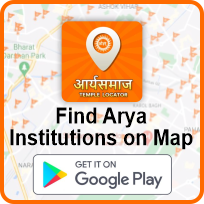

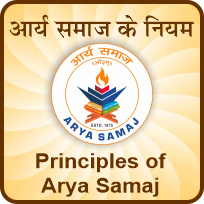







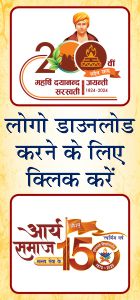
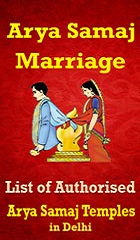
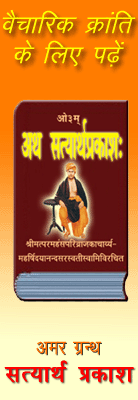


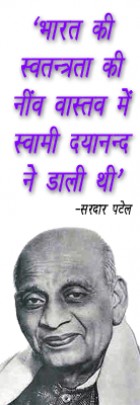
ALL COMMENTS (0)